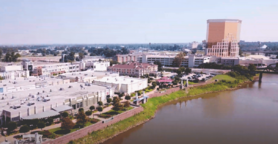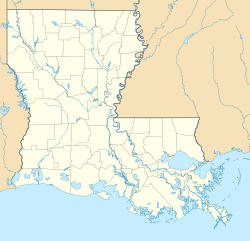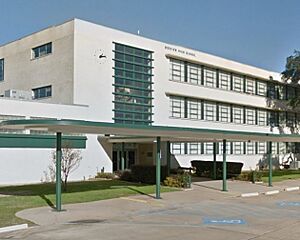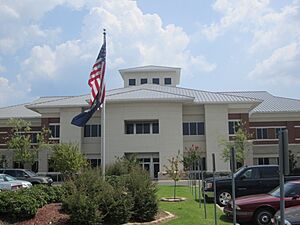Bossier City, Louisiana facts for kids
Quick facts for kids
Bossier City
|
||
|---|---|---|
| City of Bossier City | ||
|
Downtown
Louisiana Boardwalk
Magaritaville Casino
Twelve Mile Bayou
First Baptist Church
Brookshire Grocery Arena
|
||
|
||
| Motto(s):
"Union, Justice, Confidence"
|
||
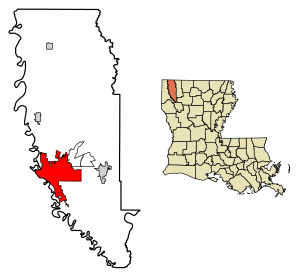
Location of Bossier City in Bossier Parish, Louisiana
|
||
| Country | ||
| State | ||
| Parishes | Bossier | |
| Founded | 1907 | |
| Named for | Pierre Bossier | |
| Area | ||
| • City | 45.02 sq mi (116.60 km2) | |
| • Land | 43.85 sq mi (113.57 km2) | |
| • Water | 1.17 sq mi (3.03 km2) 1.89% | |
| • Metro | 2,698 sq mi (6,987.8 km2) | |
| Elevation | 174 ft (53 m) | |
| Population
(2020)
|
||
| • City | 62,701 | |
| • Rank | BO: 1st LA: 7th |
|
| • Density | 1,429.90/sq mi (552.08/km2) | |
| • Metro | 393,406 (US: 140th) | |
| Time zone | UTC−6 (CST) | |
| • Summer (DST) | UTC−5 (CDT) | |
| ZIP codes |
71111-71113, 71171-71172
|
|
| Area code(s) | 318 | |
| FIPS code | 22-08920 | |
| Primary airport | Shreveport Regional Airport | |
| Interstates | ||
| Website | BossierCity.org | |
Bossier City is a city in Bossier Parish, located in the northwest part of Louisiana, United States. It's the second-largest city in the Shreveport–Bossier City metropolitan area, which is a big urban area including several cities and towns. In 2020, about 62,701 people lived there.
Bossier City is on the east side of the Red River. It's very connected to its larger sister city, Shreveport, which is on the west side of the river. They share many economic and social ties. Bossier Parish also has its own community college, Bossier Parish Community College.
Contents
History of Bossier City
Early Days in the 1800s
In the 1830s, the land where Bossier City now stands was a large farm called Elysian Grove. It was bought by James Cane and his wife, Mary Doal Cilley Bennett Cane.
James Cane and his family had a trading post across the river in what was then Caddo Indian land. This spot was called "Bennett's Bluff." They also helped start a new town called Shreve Town, which later became Shreveport.
Like many farms back then, Elysian Grove was right on the Red River. This made it easy to ship cotton and other goods by boat. A path called the Texas Trail also crossed the Red River here. The trading post used a ferry to connect Shreveport and what would become Bossier City. The farm's dock was known as "Cane's Landing," and for a short time, the area was even called Cane City.
In 1843, a new area of land east of the Red River was created and named Bossier Parish. It was named after Pierre Bossier, a former general and cotton farmer. He was one of the first European settlers in the area after most Native Americans had moved away.
In the 1840s, many Americans and immigrants moved west. More than 200 wagons a week passed through Bossier City by 1850. Many travelers were heading to Texas, but some stayed in Louisiana because of the good soil and river.
Bossier City During the Civil War
During the American Civil War, soldiers from the Confederate Army left Cane's Landing on steamboats to go to battles. Mrs. Cane hosted many soldiers at her farm.
Her farm was also protected by three forts to defend Shreveport. The main fort was Fort Kirby Smith. These forts protected the area from attacks from the east. The Civil War reached Bossier Parish in 1861 and ended in Shreveport four years later. Today, Bossier High School is built near where the fort used to be.
Shed Road: An Early Highway
The Shed Road was built in the 1870s. It was the first all-weather toll road in the southern U.S. It was about 9 miles long and went from Red Chute to the Red River. This road was covered and raised, which made it easier to move goods before railroads were common.
Becoming a City
Anna B. Cane, the granddaughter of James and Mary Cane, believed the area would grow. She started selling land lots in 1883. The area grew quickly, and transportation improved. At this time, the settlement was often called Cane City.
Around 1907, Cane City officially became a village and was renamed Bossier City. The governor of Louisiana, Newton C. Blanchard, appointed Ewald Max Hoyer as the first mayor. Bossier City kept growing and was later reclassified as a town, and then a city.
Important railroads were built through Bossier City. The first "golden spike" to finish an east-west railroad was driven here in 1884 by a woman named Julia "Pansy" Rule. Other railroads and the Dixie Overland Highway (built in 1918) made Bossier City an important transportation hub.
In 1908, oil was discovered nearby, which brought a big oil boom to Bossier City. Its location near the oil fields made it a key player in the oil industry. This "black gold" helped the city improve many things, like its public services and economy.
A large fire in 1925 destroyed half of downtown Bossier City. This led to big improvements, including a new water system, a new city hall, and the city's first park.
In the 1930s, construction began on Barksdale Airfield, now known as Barksdale Air Force Base. This base became a training school before World War II. During the war, it trained pilots and other airmen. Today, Barksdale is the headquarters for the 8th Air Force.
Bossier City has grown a lot. From about 600 people in the 1890s, it had over 64,000 people by 2012. It started as a cotton shipping point, then a railroad town, and an oil boom town. Now, it's known for its tourism and casino gambling.
The city's casinos have helped pay for many city projects. These include the Brookshire Grocery Arena (formerly CenturyLink Center), the Louisiana Boardwalk, and the Arthur Ray Teague Parkway along the Red River.
Recent Growth and Changes
In 2017, city leaders said that Bossier City was growing "outstandingly." With about 69,000 people in 2015, it was the sixth-largest and fastest-growing city in Louisiana. The city and parish work closely together, and leaders expect continued growth.
Geography and Climate
Where is Bossier City?
Bossier City is located in the Ark-La-Tex region, where Arkansas, Louisiana, and Texas meet. It sits about 174 feet above sea level. The city is mostly on the banks of the Red River. Unlike Shreveport, Bossier City has mostly flat land. There are also smaller waterways like Flat River and Red Chute Bayou that help drain the city.
The city covers about 43.85 square miles of land. About 1.17 square miles of the city is covered by water.
Bossier City's Weather
Bossier City has a humid subtropical climate. This means it has hot, humid summers and mild winters.
In warmer months, the city often has strong thunderstorms with heavy rain, strong winds, hail, and sometimes tornadoes. Bossier City gets a bit more tornadoes than the average U.S. city. Because the land is flat and there are many small waterways, the city can sometimes have serious floods. A big flood happened in March 2016, forcing many people from their homes. In winter, it can also get freezing temperatures and ice storms.
| Climate data for Bossier City, Louisiana (Shreveport Regional Airport), 1981–2010 normals, extremes 1871–present | |||||||||||||
|---|---|---|---|---|---|---|---|---|---|---|---|---|---|
| Month | Jan | Feb | Mar | Apr | May | Jun | Jul | Aug | Sep | Oct | Nov | Dec | Year |
| Record high °F (°C) | 85 (29) |
89 (32) |
92 (33) |
96 (36) |
102 (39) |
104 (40) |
108 (42) |
110 (43) |
109 (43) |
99 (37) |
88 (31) |
84 (29) |
110 (43) |
| Mean maximum °F (°C) | 76.1 (24.5) |
79.4 (26.3) |
84.4 (29.1) |
87.5 (30.8) |
92.2 (33.4) |
95.5 (35.3) |
99.4 (37.4) |
100.9 (38.3) |
97.2 (36.2) |
91.1 (32.8) |
82.6 (28.1) |
76.6 (24.8) |
101.8 (38.8) |
| Mean daily maximum °F (°C) | 57.3 (14.1) |
61.5 (16.4) |
69.5 (20.8) |
76.9 (24.9) |
83.8 (28.8) |
90.1 (32.3) |
93.4 (34.1) |
94.1 (34.5) |
88.2 (31.2) |
78.2 (25.7) |
67.5 (19.7) |
58.5 (14.7) |
76.6 (24.8) |
| Mean daily minimum °F (°C) | 36.2 (2.3) |
39.7 (4.3) |
46.3 (7.9) |
53.6 (12.0) |
62.7 (17.1) |
69.5 (20.8) |
72.7 (22.6) |
72.1 (22.3) |
65.6 (18.7) |
54.6 (12.6) |
45.2 (7.3) |
37.7 (3.2) |
54.7 (12.6) |
| Mean minimum °F (°C) | 20.3 (−6.5) |
24.6 (−4.1) |
29.6 (−1.3) |
37.4 (3.0) |
49.3 (9.6) |
60.7 (15.9) |
67.2 (19.6) |
64.8 (18.2) |
51.3 (10.7) |
38.3 (3.5) |
29.1 (−1.6) |
21.7 (−5.7) |
17.3 (−8.2) |
| Record low °F (°C) | −2 (−19) |
−5 (−21) |
15 (−9) |
31 (−1) |
39 (4) |
52 (11) |
58 (14) |
53 (12) |
42 (6) |
28 (−2) |
16 (−9) |
5 (−15) |
−5 (−21) |
| Average precipitation inches (mm) | 4.20 (107) |
4.75 (121) |
4.14 (105) |
4.19 (106) |
4.93 (125) |
5.40 (137) |
3.65 (93) |
2.73 (69) |
3.16 (80) |
4.96 (126) |
4.53 (115) |
4.77 (121) |
51.41 (1,305) |
| Average snowfall inches (cm) | 0.6 (1.5) |
0.5 (1.3) |
— | 0 (0) |
0 (0) |
0 (0) |
0 (0) |
0 (0) |
0 (0) |
0 (0) |
0 (0) |
0.3 (0.76) |
1.4 (3.6) |
| Average precipitation days (≥ 0.01 in) | 9.0 | 9.1 | 9.2 | 7.6 | 9.5 | 9.2 | 8.1 | 6.4 | 6.9 | 8.0 | 8.7 | 9.6 | 101.2 |
| Average snowy days (≥ 0.1 in) | 0.3 | 0.3 | 0.1 | 0 | 0 | 0 | 0 | 0 | 0 | 0 | 0 | 0.1 | 0.8 |
| Average relative humidity (%) | 72.6 | 69.7 | 67.7 | 69.6 | 73.2 | 73.3 | 72.4 | 71.7 | 73.6 | 71.7 | 73.7 | 74.4 | 72.0 |
| Mean monthly sunshine hours | 158.3 | 172.8 | 213.1 | 231.2 | 267.1 | 297.9 | 317.9 | 300.7 | 249.8 | 235.8 | 176.8 | 158.4 | 2,779.8 |
| Percent possible sunshine | 50 | 56 | 57 | 59 | 62 | 70 | 73 | 73 | 67 | 67 | 56 | 51 | 63 |
| Source: NOAA (sun and relative humidity 1961–1990) | |||||||||||||
People and Culture
Population and Diversity
| Historical population | |||
|---|---|---|---|
| Census | Pop. | %± | |
| 1890 | 202 | — | |
| 1910 | 775 | — | |
| 1920 | 1,094 | 41.2% | |
| 1930 | 4,003 | 265.9% | |
| 1940 | 5,786 | 44.5% | |
| 1950 | 15,470 | 167.4% | |
| 1960 | 32,776 | 111.9% | |
| 1970 | 43,769 | 33.5% | |
| 1980 | 50,817 | 16.1% | |
| 1990 | 52,721 | 3.7% | |
| 2000 | 56,461 | 7.1% | |
| 2010 | 61,315 | 8.6% | |
| 2020 | 62,701 | 2.3% | |
| U.S. Decennial Census 2018 Estimate |
|||
Bossier City has grown a lot since 1890, when it had only 202 people. By 2020, its population reached 62,701.
Bossier City is a diverse place. In 2020, about half of the people were White (not Hispanic or Latino). About 30% were Black or African American. Other groups included Asian, Native American, Pacific Islander, and people of two or more races. About 10% of the population was Hispanic or Latino. This shows that Bossier City, like many places in the U.S., is becoming more diverse.
The average household in Bossier City has about 2.44 people. In 2019, the average income for a household was about $50,340.
Religion in Bossier City
Most people in Bossier City are Christian. Many are Baptists, and others are Methodists or Catholics. There are also smaller groups of Pentecostals, Latter Day Saints, Presbyterians, Lutherans, and Episcopalians. A small number of residents follow Islam or other religions like Judaism, Hinduism, or Buddhism.
Education in Bossier City
All students in Bossier City attend schools in the Bossier Parish Schools system.
Elementary Schools
- Apollo Elementary School
- Bellaire Elementary School
- Bossier Elementary School
- Central Park Elementary School
- Curtis Elementary School
- R.V. Kerr Elementary School
- Meadowview Elementary School
- Plantation Park Elementary School
- Stockwell Place Elementary School
- Sun City Elementary School
- Waller Elementary School
Some parts of Bossier City are also served by W.T. Lewis Elementary, T. L. Rhodes Elementary, Platt Elementary, Princeton Elementary, and Elm Grove Elementary, which are just outside the city limits.
Middle Schools
- Cope Middle School
- Elm Grove Middle School
- Greenacres Middle School
- T.O. Rusheon Middle School
Haughton Middle School also serves a part of Bossier City.
High Schools
- Airline High School
- Bossier High School
Parkway High School and Haughton High School also serve some areas of Bossier City.
Colleges and Universities
For higher education, students can attend Bossier Parish Community College or Northwest Louisiana Technical Community College. There is also a four-year institution:
- Louisiana Tech University at Shreveport-Bossier City
Media and Entertainment
Local Media
Bossier City shares its news with Shreveport. The local newspapers are the Bossier Press-Tribune and Shreveport Times. There are also local magazines like The Forum, City Lights, and SB Magazine. The city also shares television and radio stations with Shreveport and the Texarkana metropolitan area.
Music and Pop Culture
Bossier City has been mentioned in several songs. For example, "Bossier City" is a song by David Allan Coe. Johnny Rodriguez and Turnpike Troubadours have also recorded songs about the city.
Sports and Fun Activities
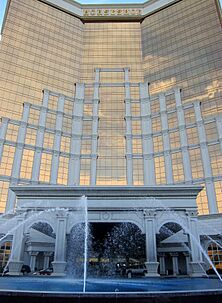
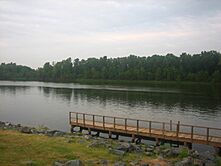
From the 1930s to the 1970s, Bossier was famous for its entertainment area called The Bossier Strip. This area along U.S. Highway 80 had many nightclubs.
Bossier City and Shreveport share a women's flat track roller derby team called the Twin City Knockers. They started in 2010 and play at Hot Wheels skating rink.
The Brookshires Grocery Arena (formerly CenturyTel Center) in Bossier City has hosted many events. It was home to the Bossier–Shreveport Battle Wings (a football team) and the Bossier-Shreveport Mudbugs (a hockey team). Famous performers like Britney Spears and Aerosmith have played there. It also hosts rodeos, ice shows, and kids' entertainment.
The city has three riverboat casino resorts along the Red River: Margaritaville, Horseshoe, and Boomtown. You can also find Horse racing and slot machines at Louisiana Downs, which opened in 1974.
Notable People from Bossier City
- Jimmy Boyd, a state representative.
- Henry Newton Brown Jr., a judge and district attorney.
- Jeff Cox, a judge.
- Raymond Crews, a state representative.
- Tim Dement, an Olympic boxer and former police detective.
- Ryan Gatti, a state senator and lawyer.
- Eurlyne Howell, a former Miss Louisiana USA.
- Mike Johnson, the current Speaker of the United States House of Representatives.
- Keith Lehr, a two-time poker champion.
- Jared Leto, a famous actor and musician, was born here.
- Shannon Leto, a musician and Jared Leto's older brother, was also born here.
- Judi Ann Mason, a Hollywood screenwriter and producer.
- John McConathy, a professional basketball player and school superintendent.
- Mike McConathy, a basketball coach.
- Alex Pourteau, a professional wrestler.
- Buddy Roemer, a former U.S. Representative and Governor of Louisiana.
- Charles E. Roemer II, a farmer, businessman, and politician.
- B. J. Ryan, a professional baseball player.
- Jeffrey D. Sadow, a political scientist and professor.
- Jeff R. Thompson, a state representative.
- David Toms, a professional golfer.
- Randy Walker, a professional American football player.
- Todd Walker, a professional baseball player.
- Jesse Winchester, a musician and songwriter.
See also
 In Spanish: Bossier City para niños
In Spanish: Bossier City para niños


